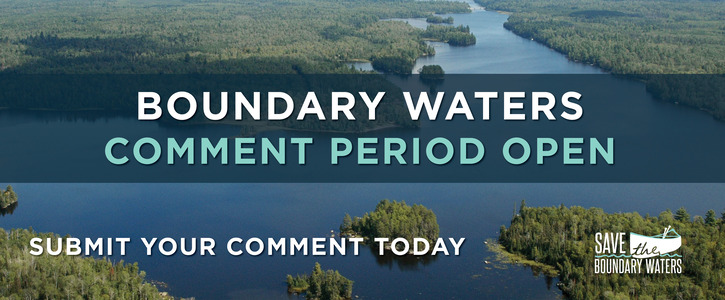I strongly support the proposed mineral withdrawal to protect the watershed of the Boundary Waters Canoe Area Wilderness ("Boundary Waters"). The threats posed by sulfide-ore copper mining are unjustifiable in the watershed of such a sensitive and important area.
The Boundary Waters is America's most popular and water-rich Wilderness Area. Its 1.1 million acres contain more than 1,000 pristine lakes and 1,200 miles of river and stream, offering unmatched fishing, hunting, and other public lands wilderness recreational opportunities for all Americans to enjoy. Priceless and irreplaceable, the Boundary Waters must not be put at risk of perpetual pollution from the most toxic industry in America.
During environmental review of the proposed withdrawal, please be sure to thoroughly address the following:
--Cleanest water quality in North America - The lakes, rivers, and streams of the Boundary Waters watershed are among the cleanest waters in North America, and are especially sensitive to acids and heavy-metals found in copper mine pollution;
--America's most visited & accessible wilderness destination -The Boundary Waters is the most popular Wilderness Area in the U.S., and the largest east of the Rockies and north of the Everglades. Visitors travel through it by boat or canoe, and can choose routes to avoid having to carry their gear, making the Boundary Waters more accessible to families, children and people with physical limitations; and
--Economics - The Boundary Waters supports a strong, sustainable, growing outdoor recreation industry inMinnesota. It is a principal driver of the $850 million, 17,000-job recreation economy in Northeastern Minnesota, it contributes to hundreds of manufacturing jobs, and it helps keep and attract talent to Minnesota.
I urge the Bureau of Land Management to withdraw the 225,378 acres of national forest lands to protect the Boundary Waters from the threat of endless sulfide-ore copper mining pollution. Thank you for the opportunity to comment.
Why is this important?
The Boundary Waters Wilderness in northeastern Minnesota is America's most-visited Wilderness, a wildland refuge critical to people and the planet. Anishinaabe people (also known in this region as Chippewa or Ojibwe) have lived in the area for countless generations and have a deep relationship to these lands and waters. Indigenous people continue to harvest wild rice in the Boundary Waters region and maintain treaty rights to hunt, fish and gather. As sovereign nations, tribes play a central role in protecting the Boundary Waters and have called for its protection.
This wild and beautiful place is threatened by proposed sulfide-ore copper mining, but we can protect this place if enough people take action. Visit
www.SavetheBoundaryWaters.org to learn more.
How it will be delivered
Digital delivery to Bureau of Land Management


